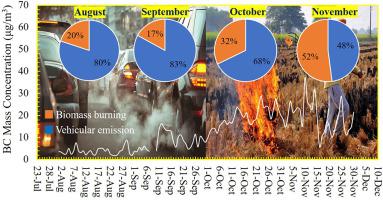Urban Climate ( IF 6.4 ) Pub Date : 2021-07-24 , DOI: 10.1016/j.uclim.2021.100926 Vikas Goel 1 , Naba Hazarika 2 , Mayank Kumar 3 , Vikram Singh 4

|
Present study investigates the temporal and diurnal variations of Black Carbon (BC) and quantifies the contribution of fossil fuel (BCff) combustion and biomass burning (BCbb) to the BC concentrations in Delhi using the Aethalometer model. The average BC mass concentration and Absorption Angstrom Exponent were 12.6 ± 8.2 μg/m3 (range: 1.73–37.0 μg/m3) and 1.30 ± 0.16 (range: 1.06–1.82), respectively. The average BCff and BCbb mass concentrations were 7.90 ± 4.98 μg/m3 (range: 1.13–19.98 μg/m3) and 4.73 ± 5.23 μg/m3 (range: 0.21–26.85 μg/m3), respectively. The contribution of BCbb was 31.15% and BCff was 68.85% to the overall BC concentration in the study period. The highest BCbb contribution, amounting to 52.04%, was found in the month of November (stubble burning season). The effect of Diwali firecrackers on BC concentrations was also investigated which was transient, lasted for few hours only. The probable major source regions of BC to the receptor site were Rajasthan, Gujarat, Punjab, Indo-Gangetic Plain and parts of Pakistan during monsoon season while Punjab, Haryana, and parts of Uttar Pradesh during post-monsoon season. The results revealed that the biomass burning activities in Punjab and Haryana contribute significantly to the Delhi's post-monsoon air pollution suggesting urgency to implement the carbonaceous aerosols emission abatement strategies over northern India.
中文翻译:

德里上空黑碳的来源解析:以极端生物质燃烧事件和排灯节为例
本研究调查了黑碳 (BC) 的时间和昼夜变化,并使用 Aethalometer 模型量化了化石燃料 (BC ff ) 燃烧和生物质燃烧 (BC bb ) 对德里黑碳浓度的贡献。平均 BC 质量浓度和吸收埃指数分别为 12.6 ± 8.2 μg/m 3(范围:1.73–37.0 μg/m 3)和 1.30 ± 0.16(范围:1.06–1.82)。BC ff和 BC bb的平均质量浓度分别为 7.90 ± 4.98 μg/m 3(范围:1.13–19.98 μg/m 3)和 4.73 ± 5.23 μg/m 3(范围:0.21–26.85 μg/m 3)。BC的贡献bb为 31.15%,BC ff为研究期间总 BC 浓度的 68.85%。BC最高bb11 月份(秸秆焚烧季)的贡献率为 52.04%。还研究了排灯节鞭炮对 BC 浓度的影响,这种影响是短暂的,仅持续几个小时。BC 到受体站点的可能主要来源地区是季风季节期间的拉贾斯坦邦、古吉拉特邦、旁遮普邦、印度-恒河平原和巴基斯坦的部分地区,而在季风季节后的旁遮普邦、哈里亚纳邦和北方邦的部分地区。结果表明,旁遮普邦和哈里亚纳邦的生物质燃烧活动对德里季风后的空气污染有显着影响,这表明在印度北部实施碳质气溶胶排放减排战略的紧迫性。


























 京公网安备 11010802027423号
京公网安备 11010802027423号